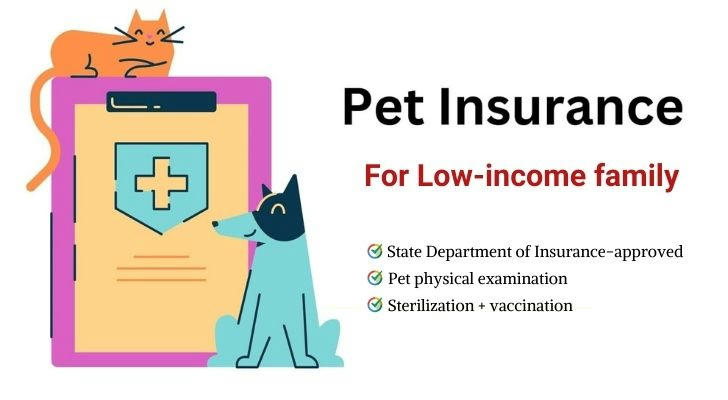🐾 U.S. Pet Assistance Programs for Low-Income Senior Pet Owners
Senior Pet Assistance Guide
In the United States, pets are an important source of companionship and emotional support for many older adults. Studies show that more than half of adults aged 50 to 80 own a pet, with dogs being the most common. However, as pets age, veterinary costs continue to rise. Seniors on fixed incomes often struggle to afford high medical expenses, and the same challenge exists for low-income families, individuals with disabilities, and veterans. Pet assistance programs can provide financial support, help share...

👥 Who Pet Assistance Programs Are For
- Seniors
- Low-income families
- Individuals with disabilities
- Veterans and those with special health needs
🐾 Benefits of Pet Assistance Programs
- Reduce upfront burden: Programs may offer installment payments or low-cost support, making pet care more affordable.
- Flexibility for medical expenses: Assistance can help cover part of the costs for emergencies or illnesses, avoiding large one-time payments.
- Timely support: Eligible pet owners can receive aid quickly after approval, ensuring pets get the necessary care without delay.
- Community mobile veterinary services: Some programs include mobile vet clinics that bring care directly to neighborhoods, making services more accessible and affordable for rural or underserved groups.
- Combination increases options: Using different programs together or combining with community aid can help cover both large expenses and routine care.
- Budget-friendly planning: Installments or subsidies allow pet owners to plan monthly expenses while maintaining pet health on a fixed income.
🧭 How to Use Pet Assistance Programs
Check if you qualify
Most programs are designed for low-income families, seniors, veterans, individuals with disabilities, or pet owners facing emergencies. Review requirements and prepare income proof, medical records, or other documents.Choose the right type of assistance
- Emergency medical aid: For sudden illness or injuries.
- Long-term or chronic care aid: Helps cover ongoing treatment for conditions such as diabetes or heart disease.
- Preventive and routine care: Some programs subsidize vaccines, spay/neuter, or wellness exams.
Apply for multiple programs
Different organizations focus on different needs. Applying to several programs can improve approval chances. Prioritize emergency funds first, then look for long-term support.Contact partner organizations
Many programs partner with veterinary clinics, shelters, or community groups. Before appointments, ask if your vet works with any assistance programs to reduce costs directly.Use community resources
Nonprofits and local humane societies often host low-cost vaccine days or mobile vet clinics. These usually require no lengthy applications—just show up and participate.Track renewals and extra support
Some programs allow renewals or additional aid, such as pet food or temporary foster care. Stay in contact with the organization to continue receiving help.
📊 Pet Assistance Programs Overview
| Program Name | Eligible Groups | What It Offers | How to Apply | Notes |
|---|---|---|---|---|
| Guardian HEALS | Low-income seniors, people with disabilities, veterans | Veterinary cost aid | Online application | Requires income proof and vet bills |
| CareCredit | All pet owners | Medical financing | Online application | Installment payment options available |
| Scratchpay | All pet owners | Medical financing | Online application | Offers installment plans |
| ASPCA | Low-income pet owners | Veterinary cost aid | Online application | Requires income proof |
| Local Humane Societies | Low-income pet owners | Veterinary cost aid | Contact local agency | Availability varies by location |
📖 Example: Ralph’s Pet Support Story
Ralph, a retired senior, owns a 10-year-old Labrador named Buddy. Last year, Buddy was diagnosed with cancer, and treatment costs totaled $10,000. On a fixed income, Ralph could not pay everything at once. Fortunately, he had pet insurance and also used pet assistance programs and community support to pay bills in installments. With this combination, Ralph covered Buddy’s surgery, medications, and rehabilitation while easing his financial burden. Buddy recovered successfully, and Ralph gained peace of mi...
✅ Recommendations
- Pet owners with limited budgets: Choose low-cost assistance programs and installment options for emergencies.
- Owners seeking full coverage: Combine insurance with community support to handle high medical costs.
- Low-income pet owners: Apply for community or ASPCA aid and pair with a low-premium plan.
💡 Conclusion
Pets are invaluable companions, bringing joy and emotional support. As they age, medical costs can rise steeply. By learning about pet assistance programs, exploring available resources, and combining installment plans, savings, and community aid, pet owners can ensure their pets receive necessary care while reducing financial stress. This approach helps owners enjoy quality time with their beloved pets with peace of mind.
